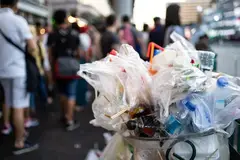Ferry Books turns risograph printing waste into wrapping for book blind boxes
The Netherland-based Ferry Books Bookstore has created book packaging using discarded risograph prints in a creative twist on environmental sustainability and design. Customers receive a surprise selection of books from a designated category, each individually wrapped in risograph print scraps, creating a “blind box” experience, layered in vibrant ink.
The process of creating risograph art is a digital stamp printing or digital screen printing technique known for its layered textures and vivid colors. Despite being an eco-friendly process due to its low energy usage and soy-based inks, risograph printing generates paper waste during production.
Yishan Du, the owner of Ferry Books Bookstore, tells Packaging Insights: “Our bookstore sits above a risograph workshop where nearly twenty artists come and go, and every morning I see their ‘failures’ stacked on the shelves: slightly misaligned colors, over-inked patches, pieces they set aside with a sigh. But to me, they’re beautiful — they carry the energy of trial, error, and play.”
“I like to think of it as small-scale, everyday sustainability. Rescuing the almost-forgotten, the ‘not quite right’ things, and giving them a second life through packaging design: it’s about celebrating the beauty of what almost was.”
Innovation from imperfection
 Packaging crafted from Risograph prints offers visual appeal and functional protection.Artists frequently employ risograph printing for its aesthetic qualities. The inherently experimental nature necessitates extensive trial and error, often requiring multiple iterations to achieve the desired visual outcome.
Packaging crafted from Risograph prints offers visual appeal and functional protection.Artists frequently employ risograph printing for its aesthetic qualities. The inherently experimental nature necessitates extensive trial and error, often requiring multiple iterations to achieve the desired visual outcome.
Each color in a risograph print requires a separate drum and run, often resulting in misalignments, ink smudges, or saturation issues. Artists frequently discard stacks of test prints before achieving the perfect result.
“To be honest, it wasn’t some grand plan. It was more like a happy accident. Sometimes I spot a misprint that just clicks with a book: a dreamy, hazy overlay for something surreal, or a sharp, jagged misalignment for a more experimental text,” says Du.
“Other times, I let randomness play its role, like matchmaking on a whim. It’s fun to let the packaging surprise even me. I don’t see why people waste something cool when you can turn it into magic.”











